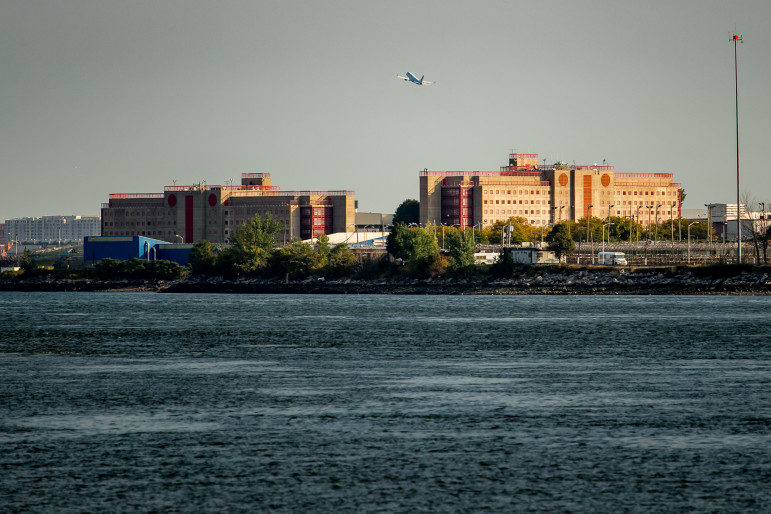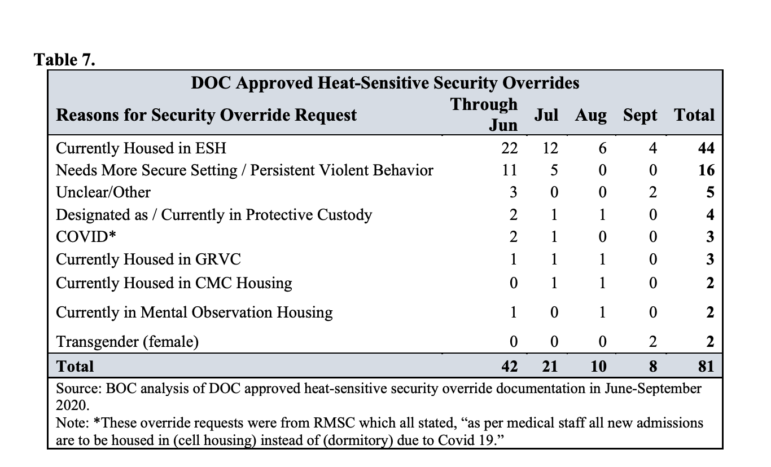Dozens of men splitting a single jug of water, sweating walls in cell units, inmates sucking air from cracks under doors—these are just some of the conditions inmates and advocates have reported from Rikers Island over the past few months.

Adi Talwar
Rikers Island, seen from the Bronx.Dozens of men splitting a single jug of water, sweating walls in cell units, inmates sucking air from cracks under doors—these are just some of the conditions inmates and advocates have reported from Rikers Island over the past few months.
This summer has seen multiple scorching heat waves that broke records and put the city’s electric grid at risk of overload. The aging infrastructure of Rikers’s facilities makes it difficult to manage temperatures under the best conditions. This, combined with massive staff shortages and a rising inmate population due to ongoing court delays, has led advocates to signal an alarm about failures in the city’s largest jail complex, where nine people in custody have died so far this year.
Although the deaths have not been linked to heat conditions, the unbearable temperatures at the jail during hot weather is among the top concerns of advocates, in addition to dire problems with violence, access to medical care and increasing incidents of self-harm among incarcerated people.
“We are in absolute crisis mode in our city’s correctional facilities, and it’s imperative that we resolve these issues as soon as possible,” Council Member Keith Powers, chair of the Criminal Justice Committee, told City Limits.
Powers said he regularly makes trips to the city’s jails, including on the hottest days of the year where temperatures reach 94 degrees in some areas. “I continue to have concerns about access to air conditioning in existing facilities, particularly in restricted housing units and for heat-sensitive individuals,” he said. Powers described the ongoing safety, staffing and heat conditions as “disturbing” and said he will be addressing them at a City Council hearing scheduled for Sept. 15.
Over this summer season, three patients from Rikers were referred to the hospital for possible heat-related illness, but none required hospital admission, a spokesperson for the Department of Correction (DOC) told City Limits.
Although the agency prepares a “heat action plan” for Rikers each year—aimed at addressing the challenges of managing heat in aging buildings—advocates say it is insufficient and often not followed, especially this year, in light of the ongoing added challenges.
The COVID-19 pandemic has delayed court proceedings, leading to longer stays in pretrial detention, a commission report says. As of July, nearly 1,000 inmates had been detained for more than 600 days. At the same time, the population of inmates continues to rise across the city’s jails. As of Aug. 20, the total number of individuals in DOC custody was 5,991, up from 4,108 on the same day last year, leading to calls for immediate decarceration efforts from advocates and a number of lawmakers.
DOC says the crisis at Rikers has been fueled by staffing shortages since the start of the pandemic. DOC staff is afforded unlimited sick time, according to the collective bargaining agreement with its union, the Correction Officers’ Benevolent Association (COBA). As of last month, 3,050 of the 8,500 uniformed staff members were absent due to sick leave, medical monitoring or simply not showing up to work, according to a recent letter filed in a federal court.
The result is an “overworked and weary workforce” forced to pull triple shifts, which have become “the new normal,” according to a legal complaint filed by the union and two associations against the city.
Unbearable heat conditions
This year’s staffing shortages have also made it more difficult for officers to manage the temperature in buildings.
The DOC’s 2021 heat action plan describes measures the agency has done to mitigate the situation, including distributing ice to individuals in non-air-conditioned units on days above 85 degrees, encouraging “summer uniforms” of t-shirts and shorts and placing industrial fans where air-conditioning units are not available.
But advocates say the plan has shortcomings, pointing to an annual heat report released by the Board of Correction in June that included a summary of heat conditions during the previous summer.
It showed that 89 percent of the more than 300 complaints and grievances received by the DOC’s Office of Constituent and Grievance Services during the summer months of 2020 were related to inoperable air conditioning units or fans, intense heat, lack of access to ice or cool showers and requests by heat-sensitive inmates to move to air-conditioned housing. As of last September, before the jail population significantly increased, 30 percent of those incarcerated were in units without air-conditioning, including 176 people considered “heat-sensitive.”
Staff is instructed to move individuals designated as “heat sensitive”—those who are older than 65 or with another condition that may make them more susceptible to heat—to an air-conditioned unit. But inmates can refuse to be moved, or DOC staff can deny the request due to a security threat.
Of the 210 heat-sensitive inmates who had not been moved in summer 2020, 26 had the request overridden because of security threats.
The Board of Correction said DOC staff employed an inconsistent procedure when documenting an inmate’s request to be moved presented a security threat. “Board staff found that some overrides were denied due to limited supporting documentation and others were approved despite having limited supporting documentation,” the report said.
The reason listed for the security threat for two individuals was because they were being held “in mental observation housing,” and for another two people, the denials were simply cited as “transgender”—though a DOC spokesperson denied to City Limits that this would be the reason for an override. The BOC did not immediately return a request for more information about the reasoning.

Even units that had air conditioning saw problems last summer, the report shows. Temperatures in air-conditioned units exceeded 80 degrees on more than 70 occasions in 2020, none of which were reported to the jail’s Central Operations Desk as required, the board’s report said.
“We’re heartened to hear that DOC has added A/C capacity to several more housing units, but there’s still just so many problems—particularly with execution of the [heat] plan,” said Robert Quackenbush, an attorney with the Prisoners’ Rights Project of the Legal Aid Society.
Quackenbush has voiced similar concerns each year. In July 2020, he wrote a letter to the DOC saying that its heat plan at the time “appears to be substantially the same plan that failed last summer, subjecting incarcerated people to unacceptable, extreme temperatures.” He told City Limits the 2021 plan was very similar to the flawed plans of previous years.
Inmates and advocates have shared similar stories this year of the plan not being followed.
An inmate detained in Rikers’s Robert N. Davoren Center (RNDC), who asked not to be named, told City Limits that although his dorm has air conditioning, it breaks every two to four weeks, sometimes even blowing out hot air. When that happens, it’s like a sweatbox, he said.
Staff will bring in a fan and turn the lights down, he said, but it does little to reduce the heat. He added that in cell units without air conditioning, the walls are sometimes sleek with condensation.
“This year we have had the fewest amount of air conditioning problems we’ve seen compared to previous years,” said a spokesperson with the DOC. Most repairs are handled as soon as they are reported, she added.
Another man also being held in RNDC, whose name City Limits is withholding for safety concerns, said he’s in a unit with about four dozen other men and they sometimes have to strip down to only shorts to endure the muggy temperatures. “It’s horrible,” he said.
Inmates are supposed to have access to water. But often, an entire dorm would only get a jug to share, reported Minister Dr. Victoria A. Phillips, a criminal justice advocate who fields complaints from inmates at the city’s jails.
The second source being held at Rikers talked about other issues that plague the facility: a bathroom speckled with black mold that creates a polka dot effect, poor ventilation and because of staff shortages, a lack of access to amenities, like the legal library and the barber shop. “We look inhumane,” he said. “When we go to court, we don’t have a proper appearance, and we scared now that we’re gonna look like animals and it affects our confidence in court.”
For inmates in solitary confinement, the conditions can be even worse, advocates say. Six of the poorly ventilated restrictive housing areas do not have air-conditioning and reached temperatures of 98.5 degrees last summer, the Board of Correction report found.
“We’ve had stories of people telling us they’ve had to bend down and put their lips on the ground to suck air from under the door because it’s so hot and humid inside those cells that they’re literally sucking for cold air from the door from any cracks they can find,” said Brandon Holmes, of the Urban Justice Center.
Inmates in the enhanced security units have been unable to get correction officers to escort them to cold showers, as promised in the DOC’s heat plan, according to Quackenbush and Powers’ office.
“We’re concerned about those in [Enhanced Supervision Housing] because of the extended lock-ins, meaning that people are confined in their cells for about 17 hours per day,” said Quackenbush. He added that the solid cell doors make ventilation impossible and make it more difficult for staff to see if someone is in medical distress.
A DOC spokesperson said the agency will not release the number of escorts available at a given time, citing security concerns, and added that they prioritize high-risk and high-need individuals. “At times, the staffing shortages have severely impacted the availability of escorts,” the spokesperson confirmed. “People have missed medical appointments due to unprecedented staffing issues, including a high number of staff members calling out sick daily.”
History of failure
The struggle to manage temperatures in Rikers’ crumbling facilities has been a problem for years.
In 2014, a homeless veteran, Jerome Murdough, died of hyperthermia in a cell that had reached nearly 100 degrees. An official told the Associated Press he had “basically baked to death.” He was being held on bail related to alleged trespassing charges.
The Independent Commission on New York City Criminal Justice and Incarceration Reform—convened to explore options for closing Rikers, and often referred to as the “Lippman Commission” after its chairman, former judge Jonathan Lippman—outlined the heat issues at the jails in a nearly 150-page report published in 2017. It noted the aging facilities at Rikers, some dating back to the 1930s, and malfunctioning heating and cooling units. “Many lack air conditioning, making for brutal conditions during the summer months,” the report said.
In July 2019, New York City experienced a heat wave, during which DOC did not follow its own procedures for protecting heat-sensitive inmates, the Legal Aid Society attested in a court record. The nonprofit also penned a letter to then-Commissioner Cynthia Brann insisting that inmates be moved to air-conditioned units.
Last year, Legal Aid filed a lawsuit against Brann and DOC alleging that the department has repeatedly denied Freedom of Information Law requests for documents related to the 2019 heat wave, including log book entries showing that ice had been distributed and refusal forms for inmates who asked not to be moved to air-conditioned units.
“From July 19–21, 2019, an extreme heat wave passed through New York City, leaving individuals in DOC custody at risk of heat exhaustion, heat stroke and other heat related ailments if appropriate measures in accordance with DOC’s policies and procedures were not taken to provide incarcerated persons relief from the heat,” the complaint asserts.
That same year, Mayor Bill de Blasio and City Council Speaker Corey Johnson announced they would close the jail by 2026, replacing it with four smaller jail facilities elsewhere in the city—a promise de Blasio had floated previously but without a solid timeline.
Eric Adams, the democratic nominee for mayor, previously said he supported closing Rikers while focusing on rehabilitation, mental health services, and mindfulness to trauma victims. “For all the effort it has taken to close the physical structures on Rikers Island, it will be much more difficult to close the pipeline that has fed Rikers for decades,” he said in a statement in 2019.
This July, the Lippman commission released a roadmap to reduce the jail population to between 2,700 and 3,150 people and close the Rikers facilities. Part of its recommendations included implementing the Less Is More Act, a state bill that would prevent sending paroled individuals back to jail based on technical violations, like missing parole appointments or being late for curfew. The bill passed the State House and Assembly in June, but has not yet been signed by the governor.
During a press conference last week, Gov. Kathy Hochul promised to take a look at the bill, citing the “inhumane, substandard conditions” at the city’s jails. “I am very concerned about what is going on in our city jails, without a doubt,” she said.
In the meantime, the efforts to mitigate heat conditions in an aging facility built on a landfill are limited to “band-aid” solutions, said Holmes. “It’s essentially like sinking swampland.”
Liz Donovan is a Report for America corps member.









2 thoughts on “As Conditions at Rikers Reach Crisis Levels, Concerns About Heat Persist”
Doesn’t the Constitution prohibit Cruel and Unusual punishment?
I think we have reached that point.
I am an inmate who was incarcerated during the summer season and heat waves I was in rmsc My email is milanilarose1985@gmail.com
Try to help me with getting into any lawsuit please I caught covid Rikers call covid March 2021 and they persuade us which one is $5 commissary to slice of pizza in June 2021 Johnson & Johnson Maxine and I have side effects Island and I got the vaccine in Rikers Island for $25 commissary in two slices of pizza Johnson & Johnson please help me with a lawyer 929-466-8609 is my phone number please call me